The Kabbalah, the Tarot and the Middle Way
Kenneth Chan
9. Reaching for Yetzirah
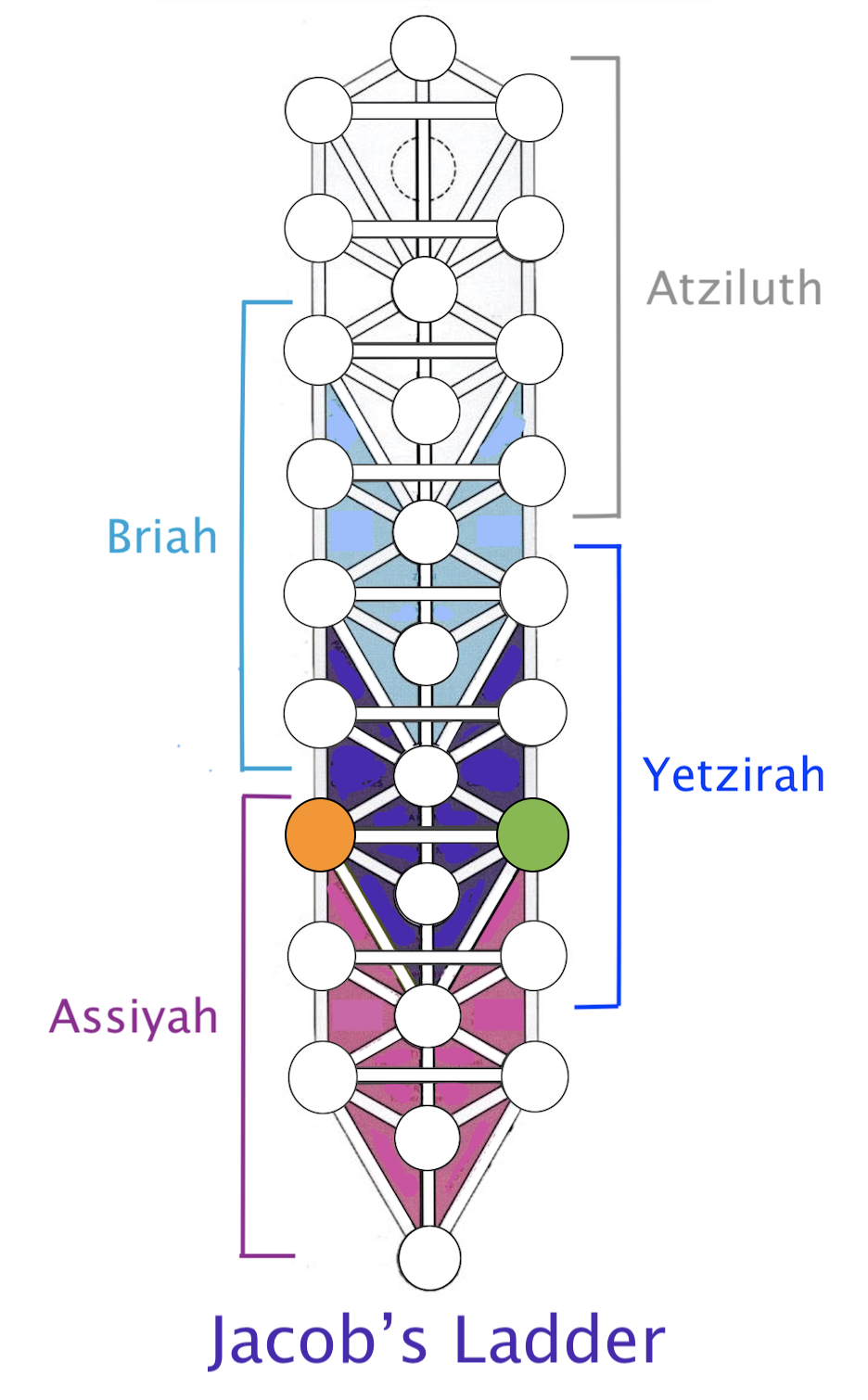
In order to open the door to the next higher World of Manifestation, Yetzirah, we need to first bring forth the qualities represented by Binah and Chokmah. Binah represents the transformed Hod which will then function as the new Hod in Yetzirah. And Chokmah represents the transformed Netzach which will then function as the new Netzach in Yetzirah. In other words, Binah and Chokmah become Hod and Netzach in Yetzirah, the next higher World of Manifestation.
This process depends on the mediation of Tiphareth, the mind of the Limitless Light, and its persistent and determined commitment to utilize the two circuits centered around Tiphareth to generate the spiritual energy needed for this journey higher up the Tree of Life. These circuits constitute the powerhouse of the Tree of Life in Assiyah that will enable us to connect with Binah and Chokmah.
With every trip we make on the circuits centered around Tiphareth, we receive a rainfall of spiritual blessings, and our spiritual potential wells up, and eventually we will have prepared four paths to bring us to a new horizon. These four paths are the ones from Geburah to Binah, and Chesed to Chokmah, and from Tiphareth to Binah, and Tiphareth to Chokmah. The new horizon is our next threshold, the horizontal path linking Chokmah and Binah, which is also the door to the next Tree of Life, Yetzirah.
We need to first instill the qualities of Binah and Chokmah through the Right and Left Pillars (i.e., via the paths from Geburah to Binah and from Chesed to Chokmah) and when the qualities of Binah and Chokmah are sufficiently primed, the long paths of insight from Tiphareth to Binah and from Tiphareth to Chokmah will appear.
Let us now look at the path that will take us up from Geburah to Binah. All the paths from Geburah to Binah, on all the Trees of Life, have the nature of an extension and an intensification of the path from Hod to Geburah. It also has the property of helping to draw forth the important long diagonal path from Tiphareth to Binah. Here, in the tree at Assiyah, the path from Geburah to Binah is described as follows:
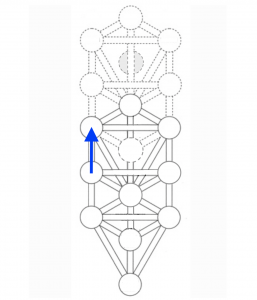
The 18th Path: Geburah – Binah
“The Eighteenth Path is called the Intelligence of the House of Influence (by the greatness of whose abundance the influx of good things upon created beings is increased), and from its midst by investigation are drawn forth the arcana and hidden senses, which dwell in its shade and which cling to it, from the cause of all causes.”
Hebrew Letter: Cheth. Fence.

This is the Intelligence of the House of Influence because it is the result of the combined influence from the paths leading from Chesed to Geburah and from Hod to Geburah. From Hod to Geburah, we learn the First Noble Truth of Buddhism, the truth that the mundane world is of the nature of suffering. And from Chesed, we gain the spiritual insights drawn from the depths of our Buddha nature, our Master Within, repeatedly refined by the circuits mediated by Tiphareth. The influence from Chesed is mainly that of nonseparation and the purity of oneness with the All. These influences, from Chesed and Hod, which we are immersed in, constitute the “House of Influence” that leads us to this path from Geburah to Binah. The words “by the greatness of whose abundance the influx of good things upon created beings is increased” refers to the fact that as our realization of our suffering nature and sense of unity deepens, the greater becomes the influx of our new motivation and aspiration directed towards fulfilling the divine will for the benefit of all.
Earlier, on the path from Yesod to Tiphareth, we turn our mind away from the mundane goals in life; and in Tiphareth, we attain the determination to be free, directing all our goals toward the spiritual. Here, via the Intelligence of the House of Influence, we take one step further. With the continual refinement of Tiphareth, we gain a deepening sense of the oneness of all, as well as a deepening realization that our mundane existence is of the nature of suffering. And we realize that it is a shared suffering, common to all. Eventually, we will understand that it is futile and senseless to work towards aims that merely benefit oneself. The word “investigation” in the Yetziratic text description refers to this realization gained by investigating the influences coming from Hod and Chesed.
With the understanding that it is futile and senseless to work towards aims that merely benefit oneself, we are ready to take this path from Geburah to Hod. Here, we renounce all goals directed only towards the benefit of oneself. The reference point for our actions is no longer the self; and we no longer work towards enhancing self-related things: our possessions, our reputation, or even our own well-being. This leaves a vacuum in our motivation and in the direction for our actions, and it is from this vacuum that “are drawn forth the arcana and hidden senses, which dwell in its shade and which cling to it, from the cause of all causes.”
When we free ourselves from the narrow confines of self-related motives, it is like a breath of new life, a fresh dawning of spiritual light. We are transported to a new world of boundlessness, a new taste of freedom, and a deeper sense of oneness and nonseparation. We will then fill the vacuum (caused by the loss of our self-related motives) with a deeper sense of compassion for all. This arises naturally, a deep welling forth from our Buddha nature. It results because we have overcome the obstacle barring our way to this vision, the obstacle of self-interest. With this removed, the natural sense of compassion and giving will arise because we know there is nothing else of value. And the way is now open to a higher spiritual direction: a transformation of our basic motives, from one based on the self, to one based on the welfare of others.
This then is “the arcana and hidden senses, which dwell in its shade and which cling to it, from the cause of all causes.” It is drawn forth when we have rid ourselves of the barrier of self-related motives. The “arcana and hidden senses” refer to the realization of truths that were, all the while, innate in us, only hidden. The arcana and hidden senses lie dormant within us until we release it by clearing away the barrier of self-related motives, a motivation which keep us in darkness and narrow confines. With this release, comes a powerful and releasing realization of deep compassion and a sense of profound oneness and beauty.
This realization naturally “dwell in the shade” of the House of Influence and “cling to it” because they are qualities that are derived from the suffering nature of samsara and the oneness of all beings. This is an echo of the Yetziratic text description of Malkuth, which states that Malkuth “sits upon the throne of Binah.” It is the influence of Malkuth which brings about the understanding of Binah, whose spiritual experience (in the Western mystical tradition) is described as the vision of sorrow. We shall look more closely at the meaning of the phrase “the cause of all causes” in our discussion of the path from Tiphareth to Binah.
This path from Geburah to Binah is essentially a path of renunciation of our worldly goals in life. The Hebrew letter assigned to this 18th path is Cheth meaning “fence” and this refers to how this path limits our motivations away from the worldly self-serving ones. The new motivation that is drawn forth, to fill the gap left by our renunciation of worldly goals, is the motivation to align with the designs of the spiritual and cosmic laws and to work for the benefit of the All. This transformation, when perfected, is the transformation of Hod into Binah. It is the fundamental transformation of our core reference perspective (upon which our motivation and behavior are derived from) into one with a higher spiritual ideal.
The words “from its midst by investigation are drawn forth the arcana and hidden senses … from the cause of all causes” also refers to another realization, and that is the one represented by the path from Tiphareth to Binah. In other words, when the path from Geburah to Binah has sufficiently primed the qualities of Binah, it will draw forth the long inspirational path from Tiphareth to Binah, which is described in the Yetziratic text as follows:
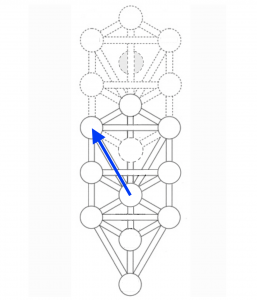
The 17th Path: Tiphareth – Binah
“The Seventeenth Path is the Disposing Intelligence which provides Faith to the Righteous, and they are clothed with the Holy Spirit by it, and it is called the Foundation of Excellence in the state of higher things.”
Hebrew Letter: Zain. Sword.
Tarot Card: Judgement
Noble Eightfold Path: Right Meditation
This path represents a realization that comes from Tiphareth, and hence represents an experiential truth that essentially radiates from our Buddha nature, our Master Within. It is a realization that is brought forth only when our mind is ready to receive it, and part of the preparation is via the path from Geburah to Binah, which represents the conscious decision to renounce our worldly aims and to focus purely on the spiritual quest.
It is always necessary to prepare our mind so that it is receptive to the higher spiritual truths before we can receive them. Otherwise, it will be like trying to fit a square peg into a round hole; it just will not fit, because our mind will subconsciously refuse to accept it. We will subconsciously reject the spiritual truth, if our mind is not ready, because accepting it entails a surrender of some aspect of our being that we are not yet ready to relinquish. That is why the path from Geburah to Binah has to be sufficiently accomplished before the path from Tiphareth to Binah can appear.
This path between Tiphareth and Binah is assigned the Hebrew letter, Zain, meaning sword. This refers to the sword of karma, the realization that any harm we do to our fellow beings will rebound on us. The sword is double edged, symbolizing the fact that our action cuts both ways, and that what we do to others will return back to affect us. As we shall see, the sword of karma is also a sword that cuts through the fog of delusions to get at the truth.
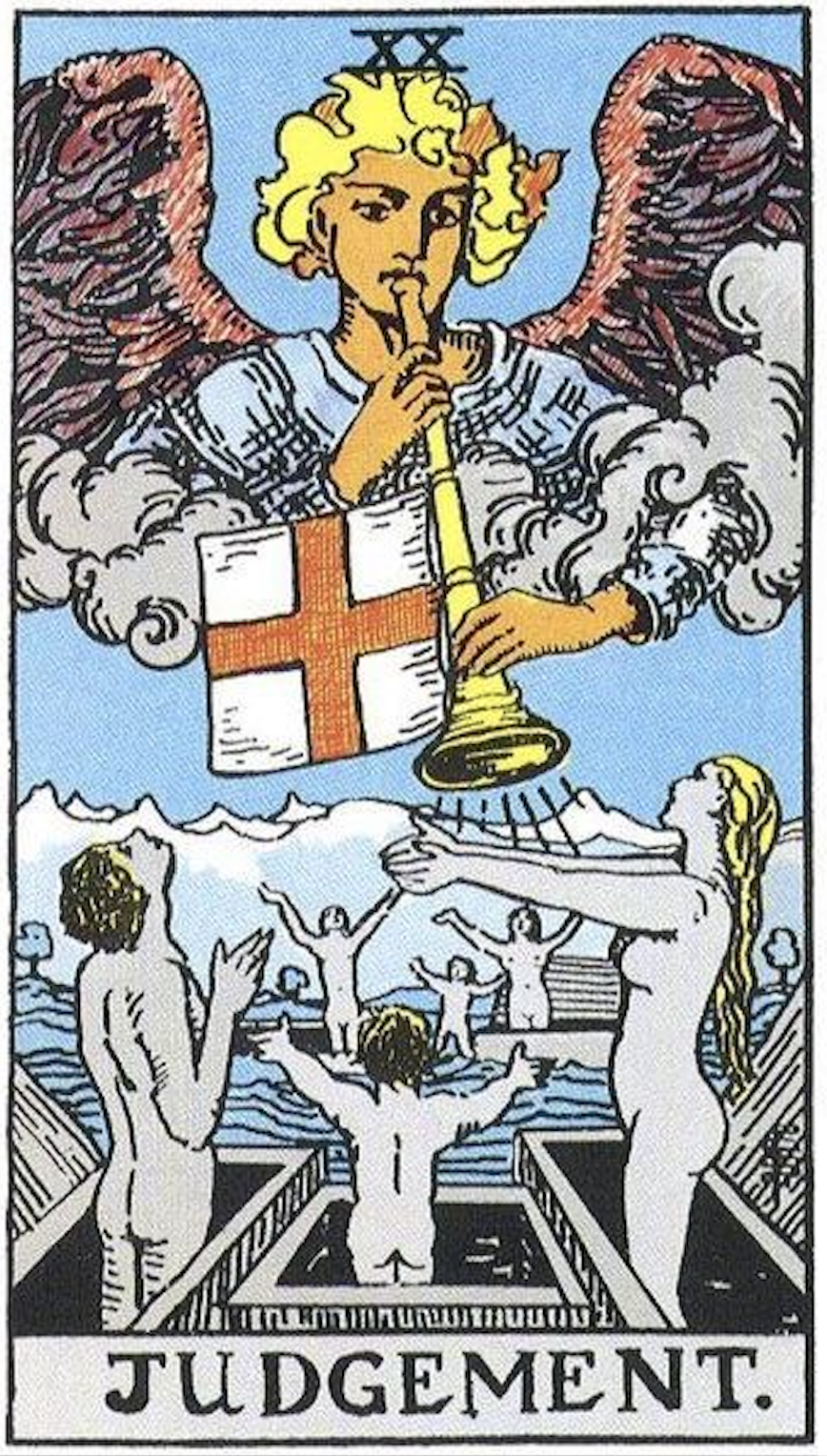
This is the first path we encounter that is also depicted by a Tarot card because this path is also a part of the next higher Tree of Life in Yetzirah. And the Tarot card for the path is Judgement, a card showing the Biblical scene of the Last Judgement. It similarly tells us that we are accountable for our actions, a reflection of the law of karma.
The picture in the Tarot also symbolizes the call to live in harmony with all others, something which the realization of karma should lead to. The call is from an angel, signifying that it comes from a divine principle, which is what the law of karma is. The Tarot card thus also suggests a rebirth, a re-awakening to a new state of being, a higher spiritual state that sees things in a new light.
Recall that, in the Yetziratic text that describes the path from Geburah to Binah, it is stated that “the arcana and hidden senses” are drawn forth “from the cause of all causes.” The meaning of the “cause of all causes” can now be seen to refer to the all-encompassing transcendent unity. It is this all-encompassing oneness that is the cause of all causes. This unity of the transcendent All is the reason for the law of karma, and hence is the cause of the causes that are the result of our karmic actions. In other words, “all causes” (in the phrase) refers to the fact that it is karma that causes the way things manifest before us, and the cause of “all causes” refers to fact that we are all bound in a spiritual tapestry of oneness. Thus, the meaning of the phrase “cause of all causes” is that it is the all-encompassing transcendent unity that is the reason for (or cause of) the law of karma.
“The arcana and hidden senses” that are drawn forth “from the cause of all causes” means that we come to realize that the reason for the law of karma is the fact that we are not separate from all others, and that is why our actions affecting others also affect ourselves. Effectively we cannot harm others without harming ourselves. That is because we are all one, and any action that harms this transcendent web that unites us, will end up harming ourselves. This is the inspirational insight that the path from Tiphareth to Binah represents, and it is the path from Geburah to Binah, when sufficiently developed, that brings forth this insight. This inspirational insight also explains why the sword of karma is also a sword that cuts through the fog of delusions to the truth.
The law of karma is, in fact, a reflection of the oneness of all, the unity of the Whole. In truth, we are all one, so we are really hurting ourselves when we hurt others. It causes a rift in the underlying fabric of the unity of all phenomena and of all beings, and this jarring rift in the underlying structure has eventually to be healed; the debt has to be paid. It is the law, and one which, sooner or later, has to come to pass.
The Yetziratic text calls this path “the Disposing Intelligence” because, at one level, it can be seen that the realization of the law of karma would dispose one towards proper actions. And it would also certainly provide “Faith to the Righteous” since, with karma, righteous behavior will be rewarded. There is however a deeper meaning to this because there is an even greater inspiration of faith from the ever-deepening experience of unity and oneness. This is a conviction that will become more profound as we progress on the spiritual path.
The 17th (Tiphereth-Binah) and 18th (Geburah-Binah) paths are aimed at achieving the same goal of transforming Hod into Binah, but they approach it from different sources. The one from Tiphareth is the realization of Binah, a new higher level of being and personality, that derives from the experiential effect of a mystical state or meditational state which is what Tiphareth represents. That is why this path is depicted in the Noble Eightfold Path as Right Meditation. It is an experiential realization.
The path from Hod to Geburah to Binah is the realization of Binah, the new higher level of being, that derives from the transformation of our foundational personality and reference perspective through the conscious effort of transforming our very lives and behavior to conform to the ever-improving vision of the truth, that which unfolds from our commitment to take every next step we know we need to take in order to become a better person. (As we shall see, this similar effect from two different means also occurs in the same way in the next higher Tree of Life in Yetzirah.)
To reach the threshold that we have to cross to get into Yetzirah, we also need to transform Netzach into Chokmah. We shall now look at the 15th (Tiphareth-Chokmah) and 16th (Chesed-Chokmah) paths, whose purpose is to transform Netzach into Chokmah, and which function in an equivalent way to that of the 17th and 18th paths in transforming Hod into Binah.
The path from Chesed to Chokmah is described in the Yetziratic text as follows:
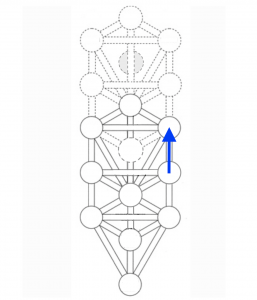
The 16th Path: Chesed – Chokmah
“The Sixteenth Path is the Triumphal or Eternal Intelligence, so called because it is the pleasure of the Glory, beyond which is no other Glory like to it, and it is called also the Paradise prepared for the Righteous.”
Hebrew Letter: Vau. Nail.
This path represents the development of the understanding which is designated as the “Triumphal or Eternal Intelligence.” It is so-called because it is “the pleasure of the Glory, beyond which there is no other Glory like to it.” In other words, it is an understanding of a spiritual principle that, when perfected, would be of the same nature as that of the highest spiritual truth. From this point on, this crucial principle would become one of the two key principles upon which the entire spiritual path would be centered upon.
This principle is the one that, in Buddhist terms, would ultimately lead to the realization of sunyata, the true nature of reality. It is the principle that, when perfected becomes the wisdom directly realizing emptiness. It is also the principle that would lead to the realization of what Plotinus, the founder of Neoplatonism, considers as “the first principle”—a supreme, totally transcendent “One,” which is indescribable directly.
It begins with a sense, here on this path between Chesed and Chokmah, of the understanding that the self is empty of inherent existence. This requires considerable explanation and great care in order to intellectually understand correctly. It forms the basis of Madhyamika philosophy, a philosophy that has been extant for two millennia. It has given rise to numerous texts and commentaries, which are essentially philosophical discourses, based on very precise logic, that explains the basis of the key principle in Madhyamika philosophy that “all things are empty of inherent existence.”
While we cannot hope to provide, here, an adequate explanation of what emptiness means, a brief mention of some critical points would be extremely beneficial. One crucial point that must be grasped immediately is that emptiness does NOT mean nihilism. If, for some reason, one were to arrive at the conclusion that the understanding of emptiness leads to nihilism, please realize that there is a flaw in the logical analytical process that led to such an erroneous conclusion. Emptiness does not mean nihilism. It is exactly because of the danger of producing such an erroneous conclusion, that the advice is given not to teach emptiness to those who are not ready for it.
A good way to understand what “emptiness of inherent existence” means is the realization that all things are empty of inherent existence because they are all dependently arisen. This means that their very existence is dependent on other factors, and they cannot be said to exist independently on their own right. If the supporting factors are not present, they cannot exist at all. All things are dependent on three factors: their parts, their causes and conditions, and the imputation by the mind that labels them. Without these three supporting factors, they cannot exist, and hence are said to be “empty of inherent existence.” It means they cannot exist independently, on their own right, “out there” on their own, without a dependence on these other factors.
What we have manifesting before us, then, is an interaction or interplay of the elements, none of which are inherently existent. In Madhyamika philosophy, it is said to be “like an illusion.” Note that it does not mean that it is an actual illusion, but only that it is like an illusion. It is like what we would have left if we describe it as “an interplay of the elements” only we need to remove the term “the elements” as well, because there are no inherently-existing elements at all. All we have is the interplay. This hopefully would provide a correct sense of what being “like an illusion” means.
This understanding of emptiness is important on the spiritual path because there is a profound effect when we realize that the self is empty of inherent existence. Students of Madhyamika philosophy are often asked to meditate on trying to locate the self. If we were to undertake such a search for the self, the “I” that we are generally so concerned about, we would realize that we cannot locate it at all.
In Romeo and Juliet, Shakespeare expresses this understanding when he has Juliet say: “What’s Montague? It is nor hand nor foot nor arm nor face nor any other part belonging to a man.” If we search for Romeo, like the search for the “I,” we will not be able to locate him. The hand is not Romeo, neither is the arm, nor the face, nor any other part of the body. If we say, instead, that it is the combination of all the parts that is Romeo, we are then making the illogical deduction that Romeo is made up of many parts, none of which are Romeo. How can an entity inherently exist when it is composed of parts, none of which can be identified as that entity?
Nonetheless, we do call the combination of the body parts “Romeo.” This, of course, is necessary for communication purposes, but we must recognize that “Romeo” is then merely a label that is imputed upon this combination of parts, none of which are Romeo. If there is no mind to impute that label “Romeo” upon the combination of body parts, there is no “Romeo.” Romeo actually does not inherently exist. It is merely a label, and one that is merely imputed. Hence, “Romeo” is only dependently arisen—it is dependent on its parts, and on the imputation by the perceiving mind.
In like manner, the self can be concluded to be empty of inherent existence. This is important on the spiritual path because a loss of this sense of the self would lead to a loss of all the barriers that separate us from others. There will then effectively be no “self” and no “others.” These separate entities do not even exist inherently. There can be no separation because there is literally nothing to separate from one another. If, later and higher on the spiritual path, we reach the stage of being able to perceive this directly and deeply, we will have realized sunyata and be in a state of profound bliss. This will also be the experience of henosis described by Plotinus, an experience of a merging with the “One” that is the indescribable first principle that cannot be characterized (since any attempt to do so would wrongly suggest its inherent existence as a separate independent entity).
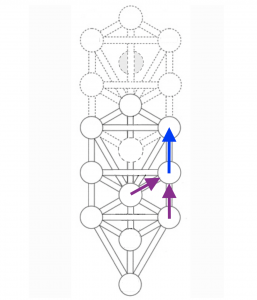
This then is why this path is described as “the pleasure of the Glory, beyond which is no other Glory like to it.” It is also called “the Paradise prepared for the Righteous” because we have to have the correct state of mind in order to receive this realization. The preparation for this realization is achieved by the earlier paths between Netzach and Chesed, and between Tiphareth and Chesed.
Recall that the earlier 21st path between Netzach and Chesed is the “Intelligence of Conciliation and Reward, and is so called because it receives the divine influence which flows into it from its benediction upon all and each existence.” This is a crucial preparation for the reward which refers to the realization of the emptiness of the self that represents the subsequent path from Chesed to Chokmah.
This preparation is necessary because we have to have sufficiently transformed ourselves away from self-cherishing tendencies, like greed, hatred, jealousy, and so on, before we can be receptive to realizing the emptiness of the self. This is because these negative tendencies all reinforce the sense of a self, since they are emotive forces that stem from wanting to satisfy the self. We hate because our self has been hurt, we are greedy because we want things for the self, we are jealous because we want our self to also have the desirable things others have, and so on. All these attitudes simply block out any realization that the self does not inherently exist. When these attitudes have been suppressed, the realization, from Chesed, that the self is empty of inherent existence will be ready to be received and this is a realization of bliss. That is why it is the “Paradise prepared for the Righteous.”
Preparation via the earlier 20th path between Tiphareth and Chesed is also required. Recall that this is the “Intelligence of Will and is so called because it is the means of preparation of all and each created being, and by this intelligence the existence of the Primordial Wisdom becomes known.” This path is our aspiration for the spiritual quest, the yearning that will bring forth the light that will dispel the darkness and show us the way. This firm commitment to the spiritual quest is needed to bring forth this realization of the existence of the Primordial Wisdom, which is also known as “the pleasure of the Glory, beyond which is no other Glory like to it.” The Primordial Wisdom and the Glory refers to the wisdom realizing emptiness, which from this point onwards becomes a crucial principle of the spiritual quest, and progressively deeper and more profound realizations of this spiritual truth will be attained as we continue upwards on Jacob’s Ladder.
While the path from Netzach to Chesed is depicted by the Hebrew letter, “palm of hand,” and the path from Tiphareth to Chesed is depicted by “fist,” this path between Chesed and Chokmah is depicted by the Hebrew letter meaning “nail.” It is the nail that firmly secures a vital and crucial means to the higher paths into Yetzirah and beyond.
This path between Chesed and Chokmah is the result of having primed Chesed sufficiently with the path from Netzach and Tiphareth. Here, our emotive and inspirational aspect takes on a higher spiritual aspect and Netzach on this Tree of Life is being transformed into Chokmah. It is the “pleasure of the Glory, beyond which there is no other Glory like to it,” because the wisdom realizing emptiness is the highest type of realization. Although we still need to develop spiritually to a deeper and more profound realization of this wisdom, it is not essentially different from what we have here been given a taste of. That is why it is also called the “Eternal Intelligence.”
With this path sufficiently developed, and Chokmah adequately primed, the inspirational realization of Right Intention will be drawn forth from Tiphareth. In a way that mirrors how the two paths leading to Binah unfold, the path from Chesed to Chokmah has to be sufficiently accomplished before the path from Tiphareth to Chokmah can appear. This is because the inner inspirational aspect of our being (represented by Chokmah) has to be ready before we can accept the transformation of our fundamental motivation in life (represented by the path from Tiphareth to Chokmah).
This path from Tiphareth to Chokmah is described in the Yetziratic text as follows:
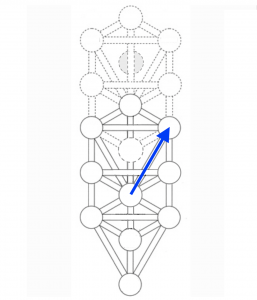
The 15th Path: Tiphareth – Chokmah
“The Fifteenth Path is the Constituting Intelligence, so called because it constitutes the substance of creation in pure darkness, and men have spoken of the contemplations; it is that darkness spoken of in Scripture, Job xxxviii. 9.`and thick darkness a swaddling band for it.’”
Hebrew Letter: Heh. Window.
Tarot Card: The Moon
Noble Eightfold Path: Right Intention
The Noble Eightfold Path depicts this path as the path of Right Intention, and it is also represented by the Tarot card, the Moon. This path works on transforming Netzach into Chokmah.
“Constituting the substance of creation in pure darkness” refers to the intention of functioning in life, as well as proceeding on the spiritual path, while realizing the emptiness of the inherent existence of phenomena. The Yetziratic text description emphasizes that the “darkness” mentioned refers to that found in the scripture of Job 38:9 because there it is stated that the darkness comes from God, since God made the thick darkness as a swaddling band around the sea. This is to indicate that “darkness” here does not indicate something of an evil nature, but rather that it is a condition that is inherent in nature since it comes from God. This darkness refers to the true nature of phenomena which is the fact that all things are empty of inherent existence. In other words, the phrase “pure darkness” in the Yetziratic description, which can also be translated as the “gloom of purity,” refers to the phenomenon of emptiness. As indicated in the Yetziratic description, this quality of emptiness has been contemplated and spoken of by men, and in particular by the Madhyamika philosophers. The path constitutes the substance of creation because it is still possible to create, and to function and build, even though all phenomena are empty of inherent existence. This understanding—that things do function even though they are empty of inherent existence—is what is known, in Madhyamika philosophy, as the Conventional Truth. The Conventional Truth is an important realization and it is the realization of the fact that appearances and functionality occur even while all phenomena are empty of inherent existence.
This path is also assigned the Tarot card, The Moon, which portrays the deceptive appearance of phenomena. The moon, which casts only a pale glow into the night, creates a shadowy world, a world of illusion. And the moon’s light is not even its own, but that reflected from the sun. The card symbolizes the illusions caused by our ignorance of the true nature of things.
Because of our self-cherishing and our desire to possess, we attribute nonexistent properties on beings and objects. We think they are permanent when they are not; we exaggerate either their good qualities or bad qualities and react by attachment or hatred. And most importantly, we think they have an inherent self-nature and hence are distinct separate entities. It is a world of illusion.

All this is reflected in The Moon card which portrays specifically the three root causes of unenlightened existence, known as the three poisons in Buddhism. The snarling wolf represents anger and hatred; the dog howling at the moon represents desire and attachment; and the two strange looking pillars at extreme sides represent delusion, our dualistic thinking, or the two extreme views of existence and nonexistence. These pillars are artificial and look out of place; they should not be there. They are there only because of our ignorance of dependent origination and the interrelatedness of all phenomena. We have to navigate all these delusions with caution and mindfulness, staying on the central path shown on the Moon card, representing the middle way, and not get caught up with the deceptive appearances of things. The Hebrew letter for this path means window, symbolizing a view to the truth.
The Tarot card, The Moon, thus accurately depicts this path which has been designated by the Noble Eightfold Path as the path of Right Intention. The Tarot card depicts a creature (the lobster) making the intention of taking the path under the light of the moon, which throws a reflected light on all below it, a light that gives a deceptive appearance to phenomena, representing how things appear even though they are empty of inherent existence. The path that is illuminated by this light goes beyond the dog and the wolf, and will leave them behind. Since the dog howling at the moon represents desire and attachment, and the snarling wolf represents anger and hatred, this path, which the creature intends to take, will have the Right Intention of leaving behind these negative qualities. Eventually the path also goes beyond the two pillars, which represent leaving behind our dualistic thinking and reaching a realization of nonduality. As mentioned, the dog, wolf, and the two pillars, represent the three poisons in Buddhism: desire, hatred, and ignorance. The Tarot card, therefore, tells us that these three poisons can be left behind and negated through the realization that all things are empty of inherent existence, and incorporating this realization in our way of functioning in life. This then is why this is the path of Right Intention.
Both Binah and Chokmah need to be developed to higher and higher levels, until Binah can replace Hod as our primordial reference perspective, and Chokmah can replace Netzach as our inspirational mind. When this has been sufficiently achieved, we will be ready to cross the critical barrier in order to enter into the next higher Tree of Life. This is the horizontal path from Chokmah to Binah—the crucial threshold of the World of Assiyah, which we must cross in order to open the door to Yetzirah.
Copyright © 2021 by Kenneth K C Chan. All Rights Reserved.